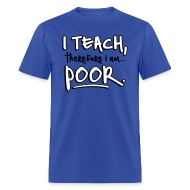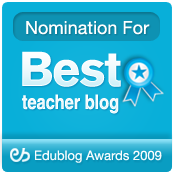The month of Guest Posts here at Learn Me Good is going well so far, but if you have been lurking, reading the posts of others, and thinking to yourself, "I wish I could write something for Mister Teacher..." Well, stop talking to yourself, and start writing! There is still room!
Here is the future calendar so far:
Today: Red Priest from Intellteacher's Blog
Jan 20: 100 Farmers from 100 Farmers
Jan 22: Mrs. T from Chucheria
Jan 28: Mr D from I Want to Teach Forever
Jan 30: Stephanie from Not Just Surviving
So you can see, there are still plenty of open days, if anyone wants to jump in and fill a gap!
Now on with today's Guest Post, which comes to us from a blogger who calls himself Red Priest. His blog is Intellteacher's Blog, which, from what I can tell, is a pretty hard-core source for true educational information! Priest blogs about learning styles, classroom management tips, educational strategies, and the like.
When I first read Red Priest's submitted Guest Post, and saw the title: Neuro-Linguistic Programming -- The Short Answer, my eyes glazed over just a bit and I will admit, I started to think of chocolate chip cookies and Guitar Hero. But for something with so jargon-y a title, it's really well written to bring the topic down to a level where we can all understand it, without TALKING down to us as readers.
So here it is -- enjoy!
______________________________________________________________
Neuro-Linguistic Programming – The Short Answer
Brief (very) History
Neuro-Linguistic Programming (NLP) first burst upon the psychological therapy scene in 1975 with the release of Richard Bandler and John Grinder’s written work, The Structure of Magic. At the time, Grinder was mostly involved in transformational grammar which was created by Noam Chomsky during the 1960s, and Richard Bandler was heavily involved in the study of mathematics with special attention to statistics. Transformational grammar is a systemic approach to uncovering the “deeper” meanings of communication by way of creating models of how grammatical knowledge is both represented and eventually processed by the brain prior to being articulated.
What Bandler and Grinder did was to apply their separate disciplines to the psychological counseling techniques of Fitz Perls, Virginia Satir and Milton Erickson. For those not in the know, Fitz, Virginia and Erickson are absolute Titans in the field of talk therapy. The ultimate outcome of Bandler and Grinder’s efforts is that they were able to identify and quantify the specific patterns present in the practices of Perls, Satir and Erickson. Arguably for the first time, the mastery of psychological counseling was revealed in a very exacting and distinct series of concrete processes … the “how do they do that” puzzle was solved.
Okay, now that your eyes are glazed over from having read the above I suppose you are saying to yourself “Gee, Frank, that’s just swell, but what does any of this have to do with my being a successful classroom teacher?” I’m absolutely delighted you asked that question, gentle readers, and the answer begins below.
In the present form, NLP provides a highly refined matrix by which a person can capture the sensory input preference(s) of any individual. Huh? Okay, try this, we have all heard and probably read a great deal about “learning styles” and the importance of employing classroom instructional techniques that take into account a student’s preferred way of learning. When we say “learning style” we are actually addressing the preferred process, and not the content proper. We can know how a person is processing information but we cannot know the actual content, e.g., we cannot read their mind. One of the major criticisms, and justifiably so, that is leveled at proponents of learning styles is that the data substantiating claims of learning style are derived from self report forms. With NLP, we avoid the whole controversy by way of directly observing a person (student) process information … we ask them nothing and they tell us everything.
There are several ways, or active systems, for identifying how a person is processing information with regard to sensory input channel selection, e.g., up inside their head making pictures (Visual Learner), listening to their inner voice run a monologue (Auditory Learning), and so on. Please keep the context of NLP’s birth and development in mind as it is crucial to understanding what you can and what you cannot use in the NLP tool box. For example, while conversing with a person I can observe their breathing and have a decent understanding of what sensory channels they are engaging at that moment. That’s all well and fine in certain settings, however, a classroom filled with students and a busy schedule to maintain is not the right time or place for such a thing.
Ideally, we would all have the opportunity to create our capture – identify matrix out of several observation systems. The truth of the matter is we as teachers do not have that luxury. So what is our best course of action given that we want to add NLP to our teaching repertoire? We go with auditory cues and by this I mean we engage in active listening with a very specific purpose.
To get a feel for how NLP might benefit you as a teacher try the following experiment for an hour or so every day for the next 3 days. Listen carefully to the person you are conversing with and keep a mental tally of the times they used words like “feel” “hear” and “see”. You are listening for patterns to emerge and here is a hypothetical conversation taking place in which you are the listener as an example: “You know, I feel real bad about the state of the economy today. I mean, it hurts me to think of all the people who lost their jobs right before the holidays. I can’t begin to imagine how painful it must have been for them to tell their Children that the holidays were going to be slim this year. Whenever I think of this mess we are in I just feel so bad inside …” Okay, now I know you are all quick studies, have all ready analyzed the hypothetical above, and properly concluded … “Aha, Kinesthetic Learner!” Congratulations, without any fuss or muss you have just correctly identified the imaginary person’s sensory input preference and you immediately converted this knowledge into a learning style label. What is more important is that you did it without them even knowing and you did it without subjecting them to some “fill in the bubble” questionnaire. You actively listened, and they told you everything you need to know in order to quickly and deeply connect with them, namely, you frame your part of the continuing conversation by using words that are kinesthetic in nature.
There are some interesting visual and auditory cues that tend to present in all sensory input preference systems, however, they are outside the scope of this short introduction article. I informed Mr. Teacher that the article I submitted would be no more than around 700 words and I’m all ready well over the limit. So, this concludes my contribution to Mr. Teacher’s Blog and I hope you not only enjoyed the post, but come away with at least a glimpse of what could be a useful tool to you in teaching.
____________________________________________________________
Check out Intellteacher's Blog for more informative posts like this one!
Let the Guest Posts keep on rollin'!
I am an Amazon.com Affiliate, and I warmly invite you to shop using my store!
Try Amazon Prime 30-Day Free Trial
Join HBO Free Trial
Try Amazon Prime 30-Day Free Trial
Join HBO Free Trial
Subscribe to:
Post Comments (Atom)











4 comments:
Thanks...that was interesting! Have you lined up Bellringers yet? She's a hoot-and-a-half!
BELLRINGERS - BELLRINGERS - BELLRINGERS ... and the crowd goes WILD. Bring It!!!
Hey, I've asked if she would, but I didn't hear back from her! I'd love to have her guest!
Ah, man ... bummer. The bell has gone silent. I was on her Blog last night. Melissa B. is correct ... Bellringers is a *HOOT*
Post a Comment